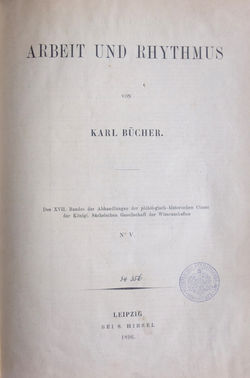
"The idea that work (biblically, the fundamental condition of human definition) was made possible through the agency of rhythm, is not entirely original with Miner. Karl Bücher's 1896 Arbeit und Rhythmus is an exhaustive study of the role of rhythm as the major structural component of human work: rhythm is grounded in the physiology of the human motor and thus fundamentally informs human labor. Although his study concerns itself mainly with the use of singing and other rhythmic accompaniments in the organization of work among primitive Naturvölker," Bücher ends his book with a chapter entitled "Rhythm as a Principle of Economic Development" ("Der Rhythmus als ökonomisches Entwicklungsprinzip"), in which he describes the gradual increased complexity of society as a "social evolutionary process" ("sozialen Evolutionsprozess") made possible by the development of ever more sophisticated work rhythms: natural rhythm "economically regulates energy needs" and promotes the ever-increasing division of labor without which "our current 'Machine-age' wouldn't have been possible." For Bücher, the entire domain of work, from the micro-level human body to the macro-level industrial corporation, is structured by the rhythms which fundamentally inform twentieth-century "machine-age" social fabrics, and which facilitate labor like "lubrication keeps the machine going" ("wie das aufgegossene Öl den Gang der Maschine"). By automating labor, rhythm liberates the mind for the more imaginative work of cultural and artistic production. Bücher complains, however, that industrial machinery alienates human labor because it does not operate at a human tempo; on the other hand, large-scale, "uniformizing" ("einförmige") work is of "the greatest benefit for a person, so long as he can determine the tempo of his bodily movements" ("Gerade die Einförmigkeit der Arbeit ist die grösste Wohltat fur den Menschen, so lange er das Tempo seiner Körperbewegung selbst bestimmen und beliebig aufhören kann"). Bücher looks forward to a time when the rhythms of machines and humans will be more perfectly integrated: ...the hope must not be abandoned, that we may one day manage to link technology and art together into a higher rhythmical unity which will return to the spirit that happy serenity, and to the body that harmonious figure, revealed in the best of the natural peoples." (Michael Golston, in: Stanford Electronic Humanities Review, V, 1996). - Vordere Umschlagseite und Titelblatt mit gelöschtem Bibliotheksstempel, sonst schönes Exemplar dieser sehr seltenen ersten Ausgabe." Preis: 100 EUR





